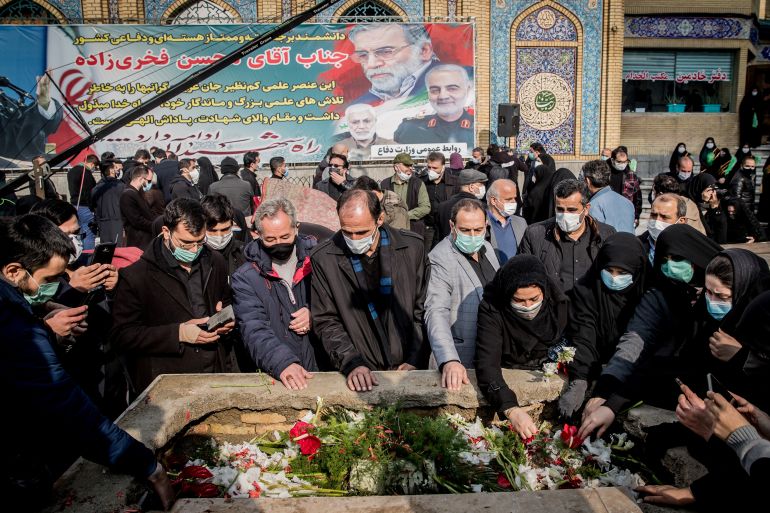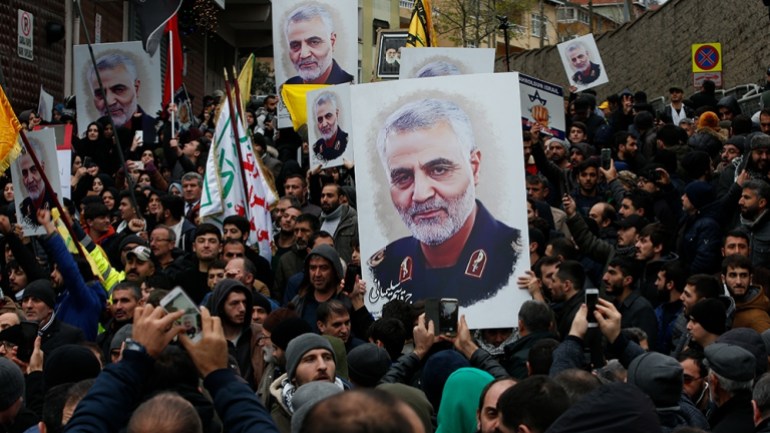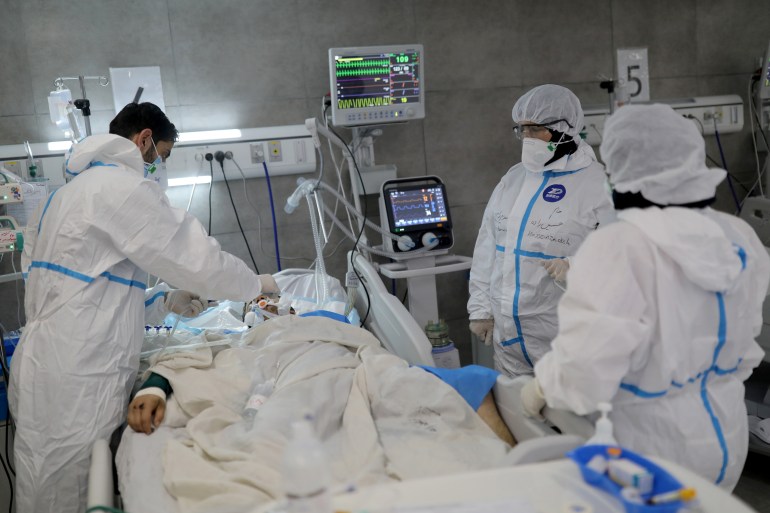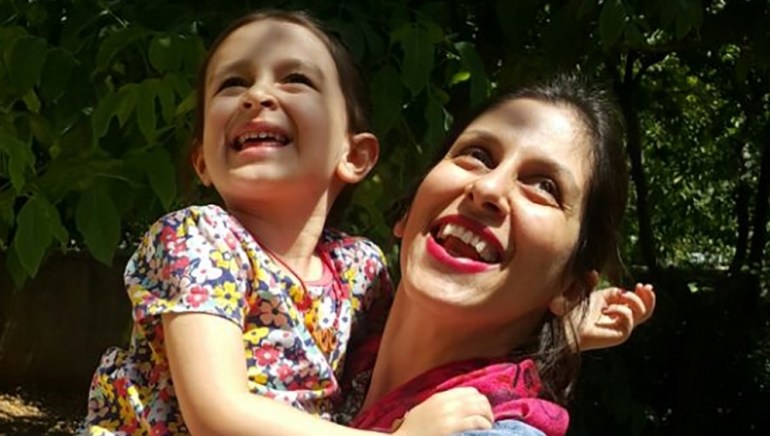Iran 2020: A tumultuous year in review
From assassinations to a crippling pandemic, Iran experienced one of its most turbulent recent years in 2020.

Tehran, Iran – For many Iranians, it already felt like things could hardly get worse only days after 2020 started.
“We wash away blood with more blood. We pile suffering upon suffering. It’s as if history has been compressed,” a group of students at the Amir Kabir University in Tehran said in a statement released in early January.
Keep reading
list of 4 itemsWhy did President Erdogan’s poem infuriate Iranians?
Mohsen Fakhrizadeh: Who was the assassinated Iranian scientist?
World powers renew commitment to preserve Iran nuclear deal
Less than two months before, protests that erupted across Iran after the price of gasoline tripled overnight were violently quashed, and 230 people died, according to the authorities.
But that student statement was published after the Islamic Revolutionary Guard Corps (IRGC) mistakenly shot down – with two missiles – a commercial aircraft operated by Ukraine Airlines over Tehran on January 8, 2020.
The aircraft, which carried mostly Iranians, many of whom held dual nationalities, was downed hours after the IRGC fired missiles at two United States military bases in Iraq.
The country was on high alert in anticipation of a potential US reprisal, leading to the deadly mistake, authorities said at the time.
The night-time attack on US interests – which bore no death – was itself a response to the January 3 assassination of General Qassem Soleimani, Iran’s top military commander and the head of the IRGC’s Quds Force which handles operations abroad.

Soleimani had just landed in Baghdad airport when a drone strike ordered by President Donald Trump destroyed his convoy, also killing several others, including a senior Iraqi commander.
Soleimani’s images were seen at every turn all over Iran for the proceeding days which also saw millions pour out into the streets across the country to mourn the general and condemn his assassination.
So many people gathered to see his body taken through his hometown Kerman that dozens died in a gruesome stampede.
Tensions between Iran and the US had been steadily on the rise during the hawkish Trump administration, which unilaterally abandoned a 2015 nuclear deal between Iran and world powers and imposed harsh economic sanctions.
But the assassination of the man whose power and influence was thought to be only second to Supreme Leader Ayatollah Ali Khamenei himself, blew tensions out of proportions.
The threat of direct military conflict hung heavy but never materialised, instead, translating into more friction and proxy conflicts in Iraq and beyond.
Iranian vessels came close to US ships in the Gulf in April, the US seized four Iranian vessels carrying fuel to fellow US-sanctioned Venezuela in August, and Iran issued an arrest warrant for Trump and dozens of other US officials for killing Soleimani in late June.
The US has also slammed several Iranian military efforts, including the launch of the country’s first military satellite, the unveiling of new missiles, and holding annual war games.
Khamenei reminded the world last week that Iran is still looking to avenge Soleimani in addition to seeking the full withdrawal of US troops in Iraq, but said it will happen “at the right time”.
COVID-19 and the economy
What ended up killing tens of thousands of Iranians and affecting the lives of millions more was not a war, but the novel coronavirus.
After weeks of speculation and denied reports, Iran finally confirmed in late February that COVID-19 had entered the country by abruptly announcing the first confirmed deaths of the deadly virus in the Middle East.
Iran has since seen three major waves of infections during the pandemic that has killed close to 54,000 and infected more than 1.1 million people. Health authorities say real numbers could be more than double the official figures.

The administration of President Hassan Rouhani has imposed two major lockdowns and several partial shutdowns throughout the pandemic.
A full lockdown was imposed in parts of March and April and another major shutdown affected hundreds of cities across Iran for two weeks in November.
Iranian officials have said the US is actively trying to block the country’s efforts to buy a vaccine through a global initiative operating under the World Health Organization (WHO).
The US has also blocked Iran’s request for a $5bn emergency loan from the International Monetary Fund to combat the deadliest pandemic of the Middle East.
But in some ways, COVID-19 did what Trump’s “maximum pressure” campaign could not as it shut borders and hugely affected non-oil exports that were on the rise in absence of significant oil exports.
Even before the pandemic, Iran’s economy was shrinking and its national currency, the rial, was in free-fall due to US sanctions. But the rial hit a nadir of 320,000 per US dollar in October while it was being traded for 40,000 before the sanctions.
But on the back of economic resilience and hopes that President-elect Joe Biden will revitalise the nuclear deal and lift sanctions, the economy is gradually stabilising and the rial has recovered to 250,000 against the greenback.
However, rampant inflation and high unemployment continue to hurt average Iranians whose quality of life has significantly deteriorated in the past three years.
“Biden is expected to be a predictable president, unlike Trump who was an unconventional, unpredictable madman in the White House,” said Ali Akbar Dareini, a researcher at the Center for Strategic Studies in Tehran.
“But it doesn’t mean that 2021 will be a year free of tensions between Iran and the US,” he told Al Jazeera, citing Biden and European signals that they want Iran to negotiate on its missiles programme and regional influence.
JCPOA and Fakhrizadeh’s assassination
Fears that Trump’s defeat in the US presidential elections could mean further escalations in relations with Iran were quickly realised.
With only two months left until Trump had to leave the White House, his Secretary of State Mike Pompeo in November went on a tour of the region that saw him visit major Iranian rivals, namely Israel, Saudi Arabia and the United Arab Emirates.
Days later, new sanctions using terrorism-related designations were announced on a host of Iranian entities and individuals, including the Ministry of Petroleum, all of whom were already sanctioned. New sanctions have been announced every week since.
The new designations are part of the Trump administration’s year-long endeavour to make it harder for a potential Biden administration to return to the Joint Comprehensive Plan of Action, as the nuclear deal is formally known.
In early October, the US completed effectively blacklisting the entire Iranian financial sector when it sanctioned 18 banks – a move which also created further humanitarian concerns since the banks predominantly cleared transactions for imports of food and medicine.
But the sanctions were dwarfed by the act of escalation that came after.
In late November, Mohsen Fakhrizadeh, a top scientist in Iran’s nuclear and military programmes, was assassinated in a city near Tehran.
Iran says Fakhrizadeh, who Western intelligence believes was the head of Iran’s nuclear weapons programme disbanded in 2003, was assassinated by Israel.
This is while in early July, a fire had ripped through a building at Natanz, a major Iranian uranium enrichment site. Authorities said it was an act of “sabotage” with the help of “internal agents” but have yet to release full details.
The assassination also came months after a series of suspicious explosions across Iran, including those at an alleged missiles facility, petrochemical and power plants, ports, and a medical clinic – the cause of most of which has not been determined and is subject to much public speculation.
Iran has promised “harsh revenge” for Fakhrizadeh, the same promise made after general Soleimani was assassinated. But a more immediate reprisal was mounted by the hardline parliament.
Within days after the scientist was assassinated, the parliament passed a bill that obligates the government to increase uranium enrichment and expel inspectors of the International Atomic Energy Agency, among other things.
The relatively moderate Rouhani and his administration are opposed to the legislation passed by the parliament that came to power following elections in February – which saw the lowest voter turnout since the 1979 revolution that birthed the Islamic Republic.
Rouhani has said he believes the country should continue the path of diplomacy that saw it defeat the US at the United Nations Security Council in August and October when the US tried to reinstate all UN sanctions on Iran and prevent the end of a decade-long arms embargo.
The supreme leader, who last week agreed to revive financial transparency legislation linked with Rouhani’s efforts to end isolation, has said Iran must strive to lift sanctions if possible, but mostly work to “nullify” them by resisting.
Amid the pressures, a war started between Armenia and Azerbaijan – both of which have borders with Iran – over the Nagorno-Karabakh enclave in which Iran tried to mediate by offering a peace plan.
After the 44-day war ended following a Russian-led peace effort, Iran and Turkey found each other in a political spat after Turkish President Recep Tayyip Erdogan recited a poem echoing the pan-Turkism doctrine that banded Iranians behind a message of national unity and territorial integrity.
Human rights, executions
Iran has been regularly criticised by the West and human rights organisations in 2020 for what they call human rights abuses but Iran slams as interference in its local affairs and those of an independent judiciary.
In December, Western leaders and global rights advocates strongly condemned the execution of dissident journalist Ruhollah Zam, who ran a popular Telegram channel that was accused of inciting violence during the 2017 national protests.
Zam, who was snatched by the IRGC in Iraq last year and was also accused of working with foreign intelligence, was swiftly hanged earlier in December only four days after Iran’s Supreme Court upheld his death sentence.
In September, international leaders – including Donald Trump – and human rights organisations called on Iran to stay the execution of a 27-year-old champion wrestler Navid Afkari, who authorities accused of fatally stabbing a man in Shiraz.
Critics said Afkari, who was executed on September 12 despite a social media storm that took the Farsi hashtag #DoNotExecute global, was punished because he participated in 2018 protests.
Iranians also took social media by storm in September when they championed their own version of the global #MeToo movement.
Prominent Iranian human rights lawyer Nasrin Sotoudeh, who was sentenced to 38 years in prison last year, remains in prison after being ordered back to prison in early December following a three-week furlough due to health concerns.
Iran has also been at odds with European powers over the detention of several dual-national citizens who are accused of spying or trying to topple the Iranian establishment.
Australian-British academic Kylie Moore-Gilbert was swapped for three Iranians held in Thailand in late November, Iranian-British charity worker Nazanin Zaghari-Ratcliffe has been under house arrest since March, and French-Iranian academic Fariba Adelkhah was temporarily released in early October.

But several others, including Swedish-Iranian academic Ahmad Reza Djalali, remain in prison.
In early December, reports of Djalali’s “imminent risk of execution” prompted Swedish Foreign Minister Anne Linde to contact her Iranian counterpart Mohammad Javad Zarif to protest.
Last week, a Canada-sponsored UN resolution denouncing human rights abuses in Iran was passed, which Iran condemned as “lacking legal basis”.